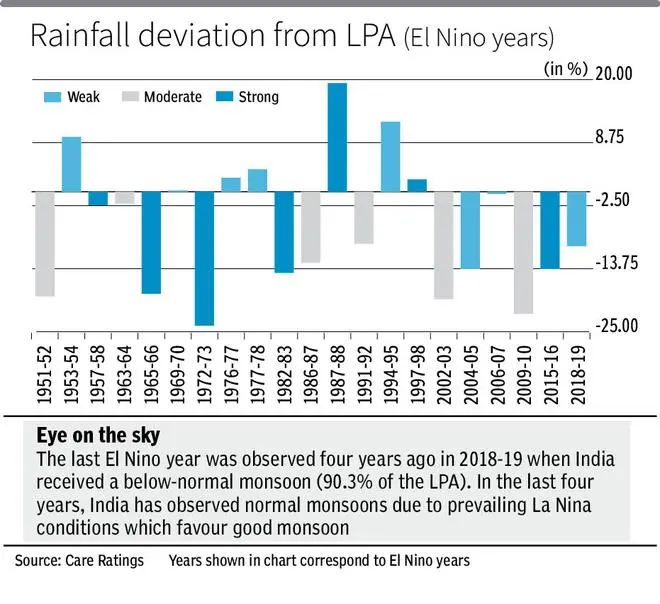The India Meteorological Department (IMD) has said there is a good chance that a moderate El Nino might emerge during the June-September monsoon season. The department was, however, circumspect about its impact on the disruption of rainfall.
The impact of El Nino may be “neutralised” with a likely positive Indian Ocean Dipole (IOD), the IMD said. Yet, some experts still apprehend a bad monsoon that could drag down the agriculture growth.
El Nino is a weather pattern that is associated with reduced rainfall in India. A higher sea surface temperature (SST) — up to 1 degree — is called weak El Nino and between 1 degree and 1.5 degree is classified as moderate.
Temperature effect
The latest Monsoon Mission Coupled Forecasting System (MMCFS) of the IMD forecast suggests that the current El Nino-Southern Oscillation (ENSO) neutral conditions are likely to continue in May.
However, it may be warmer and El Nino may emerge in the monsoon season starting from June, though the SST over the Pacific ocean may not exceed beyond 1.5 degree during the whole season. A majority of global models indicate a likely development of El Nino during the monsoon season, the IMD said.
SSTs over the Indian ocean also influence the monsoon, M Mahapatra, IMD director general, told the media on Friday. Currently, the IOD conditions are neutral; “it can turn positive anytime by June and a positive IOD is good for monsoon,” he said.
Meanwhile, the Australian Bureau of Meteorology has said there are signs that El Nino may form during the southern winter. All but one international climate models indicate El Nino setting in by August, it added. The US Climate Prediction Centre, too, has predicted El Nino formation during May-June.
“If we look at the data for the past 50 years, it can be said that on average, an episode of a strong or moderate El Nino has led to deficient or drought-like situations in India which not only affected agricultural production adversely but also corresponded to lower GDP growth,” Rajani Sinha, Chief Economist of Care Ratings, said in a report.
- Also read: The El Nino effect
Impact on crops
Sinha said the prediction of El Nino has come at a time when India is already battling with high inflation, growth slowdown concerns and weather fluctuations (heatwaves and unseasonal rains). According to the report, a below-normal monsoon can further aggravate the situation.
It is worth noting that prices of major kharif crops such as rice and pulses are already at elevated levels and a bad monsoon could affect the production of these commodities putting upward pressure on food inflation.

“What is even more important is the temporal and spatial distribution of rainfall. While States such as Punjab and Haryana have good irrigation facilities, other major crop-producing States such as Rajasthan, Maharashtra and Karnataka are more dependent on rains. Even in case of a below normal monsoon, if these States receive abundant rainfall, the harm can be contained,” she said.
IMD had, earlier this month, predicted a normal monsoon (96 per cent of average) this year. At that time, it maintained that El Nino will emerge during the second half of the monsoon season.
However, private weather forecaster Skymet has predicted a below normal monsoon (94 per cent) this year, which, if it proves to be correct, will be the first such year after experiencing ‘normal or above normal’ rainfall during the past four years.
Monsoon rainfall between 96-104 per cent of long-period average (LPA) of 868.6 mm is known as ‘normal’ and between 90-95 per cent of the LPA is considered as ‘below normal’.
(With inputs from Subramani Ra Mancombu)






Comments
Comments have to be in English, and in full sentences. They cannot be abusive or personal. Please abide by our community guidelines for posting your comments.
We have migrated to a new commenting platform. If you are already a registered user of TheHindu Businessline and logged in, you may continue to engage with our articles. If you do not have an account please register and login to post comments. Users can access their older comments by logging into their accounts on Vuukle.